 Image search results - "men" Image search results - "men" |

Ryogoku Kokugikan sumo arena as seen from Ryogoku Station
|
|

Crowd outside the Kokugikan await their favorite wrestlers.
|
|

Crowd enters the Kokugikan for Musashimaru's retirement ceremony on Oct. 2, 2004.
|
|

Passing out programs
|
|

To mark the song's 100th anniversary, a new song monument was unveiled at Kyoto University (Yoshida-South Campus) on Nov. 25, 2017.
|
|

Musashimaru at the entrance
|
|

Front side of the monument has the Japanese lyrics and explanation of the song. Monument is made of stainless steel with a brushed-metal finish.
|
|

Musashimaru greets the crowd
|
|
|
|

Hawaii's last sumo wrestler shakes hands.If he were married, his wife would be beside him.
|
|
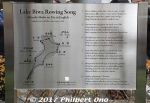
Monument's English side has a bilingual Lake Biwa map and Lake Biwa Rowing Song English lyrics.Directions: From JR Kyoto Station's Karasuma side (north side with Kyoto Tower), go to bus stop D2 and catch the No. 206 bus bound for "Gion Via Kiyomizu-dera Temple/Kitaoji Station" (三十三間堂・清水寺・祇園・百万遍). The bus leaves every 15 min. or so (bus schedule here), but it can be very crowded. The ride takes abut 30 min. Get off at "Kyodai Seimon-mae" (京大正門前). Cross the big road (Higashi-Oji-dori) and walk along Higashi-Ichijo street. The main Yoshida Campus will be on the left while the Yoshida-Minami Campus will be on the right. Enter the Yoshida-Minami Campus and walk to the central courtyard area.
(From Kyoto Station, there is also an express bus (京大快速) to Kyoto University Hospital from bus stop D3, but it runs only at certain times on weekdays, mainly in the morning and mid-afternoon (bus schedule here).
|
|

Musashimaru right after I shook his hand.
|
|
|
|

Signboard for retirement ceremony at entrance.It reads "Musashimaru, Intai Danpatsu Hiroo Ozumo" which means "Musashimaru Topknot-Cutting and Retirement Sumo Exhibition."
|
|

Omi Fair video taken on March 2, 2014 at Takashimaya Dept. Store in Nihonbashi, Tokyo. Funazushi, Omi beef, Biwa pearls, and more. We also saw Hiko-nyan.
|
|
|

Verse 1 Song Monument, Otsu (Mihogasaki). In 1973, this was the first monument built for the song. The song's first and most famous line, "Ware wa Umi no Ko" is written. 一番の歌碑。大津市三保ケ崎。This monument is near the boat house in Mihogasaki, a stone's throw from Hama-Otsu.
われは湖の子 さすらいの
旅にしあれば しみじみと
のぼる狭霧や さざなみの
志賀の都よ いざさらば
Ware wa Umi no Ko, sasurai no
tabi ni shiareba, shimijimi to
Noboru sagiri ya, sazanami no
Shiga no Miyako yo, iza saraba
|
|

Way to Takashimaya Dept. Store in Nihonbashi subway station.
|
|

Gate to Takayama Jinya
|
|

Musashigawa stablemaster (former Yokozuna Mienoumi) in the entrance hallInside the entrance hallway, there was a long table on the left side with ribbons which served as name tags for distinguished guests. Musashigawa is the name of Musashimaru's sumo stable.
|
|

Way to Takashimaya Dept. Store in Nihombashi subway station.
|
|

Entrance to Takayama Jinya. A Jinya was a regional government office during the Edo Period. The Tokugawa government dispatched magistrates to administer the region. About 60 jinya existed and only this one survives.
|
|

Entrance hall is clogged up by a side show of hula.
|
|
|

For 176 years or 25 generations, the building housed government administrators, accountants (rice tax collectors), and the police.
|
|

Musashigawa Stable wrestlers greet visitorsIncludes Miyabiyama and Musoyama.
|
|

Takashimaya got its name from Takashima, Shiga Prefecture.
|
|
|

In the entrance hall, hula and Hawaiian music direct from Hawaii
|
|

Back of Verse 1 Song Monument, Otsu (Mihogasaki)Directions: From JR Otsu Station, take a bus to Mihogasaki. It's about 10 min. Or you can easily walk it from Hama-Otsu Station. Just walk on the main road toward the race boat arena. There will be a small marina on the right. Right after passing the marina, turn right into the small road. There will be a small park on the right. The monument is there. There are two stone monuments. It might be roped off and you're not supposed to enter the park. While you're there, walk around the marina and see the boathouse with the cherry blossom logo with three stripes. That's the logo of the school and the place where the boys left for the rowing trip in 1917. Otsu Station also has a tourist information office where you can obtain directions and a map.
|
|

1st floor of Takashimaya Dept. Store.
|
|

Magistrate's (governor) office 御役所
|
|

The retirement ceremony had a lot of Hawaiian touches. This was only the beginning.Hula dancers and live Hawaiian band from Hawaii.
|
|

View of Administrator's office from the veranda
|
|

Exhibit of Nagahama bonsai plum trees and folding screen from Hikone, 1st floor of Takashimaya Dept. Store during the Grand Omi Fair.
|
|

Konishiki also sings. (His company arranged the entertainment.)
|
|
|
|

Omiko shrine maidens. On the previous day during the Sacred Carriage Procession, they performed sacred dances on a truck. お巫女
|
|

Near the Verse 1 Song Monument is another stone monument engraved with the words of the entire song.
|
|
|

Musashigawa Stable wrestler wearing Aloha-print yukataFlowery pattern (plumeria) with "Musashimaru" imprinted.
|
|

Folding screen from Hikone (National Treasure).
|
|

The main building was built in 1816.
|
|

Musashimaru souvenirs at the Kokugikan's souvenir shop
|
|

Small park where the Verse 1 monument is located.This monument is near the boat house in Mihogasaki, a stone's throw from Hama-Otsu. It was built in 1973 as the first monument for the song.
This little park is actually off-limits and you're not supposed to enter it, for some reason. On the left side of the picture is another stone monument hidden by brush. It is engraved with the entire song. In the background, you can see the roof of the boathouse.
|
|

PR exhibit for the Grand Omi Fair on the 8th floor.
|
|
|

Musashimaru merchandise
|
|
|
|
|
|

Musashimaru doll
|
|
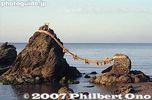
Meoto-Iwa Wedded Rocks off the coast of Futami-cho, Ise city, Mie Prefecture. 夫婦岩
|
|

1st floor of Takashimaya Dept. Store.
|
|
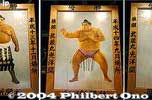
Giant painted pictures of Musashimaru decorating the arena inside. Each one commemorates a tournament victory.These giant pictures are actually black-and-white photographs taken in a photo studio and printed on large paper. Then it is hand-painted in color by a woman who has been doing it for years.
|
|
|

The Wedded Rocks are part of Futami Okitama Shrine known for frog sculptures. 二見興玉神社
|
|
|

Grand Omi Fair on 8th floor
|
|

The ceremony opens with taiko drum beating on the sumo ring.
|
|

The shrine is dedicated to Sarutahiko and Ukano-mitama. Sarutahiko is a god which serves as a pathfinder guide. Deities for land/sea transportation safety. 二見�
|
|
|

No. 4 elementary school (Dai-yon Shogakko) where you get off the bus and where the Information Center is. 第四小学校
|
|

Tourist corner with samurai armor of Hikone's Ii Clan.
|
|

Miss Nippon
|
|

Sumo exhibition matches with lower division Makushita wrestlers.A retirement ceremony for an important sumo wrestler includes a variety of activities besides the actual ceremony of cutting away the topknot. It involves almost the entire Japan Sumo Association, and most wrestlers in the top three divisions (Makushita, Juryo, and Makunouchi) also appear in exhibition matches.
|
|

The frog is Sarutahiko's messenger. Frog is called "kaeru" in Japanese, which is a homonym for the another word meaning "return home." If you travel a lot, pray here for a safe return. 夫婦岩
|
|
|

Here's one reason for the crowd...
|
|
|

Miss Nippon throw beans, but not very far.
|
|

Makushita sumo matchLower-division wrestlers wear black belts, while the upper division wrestlers wear white belts (during practice) or colored belts during official matches.
|
|
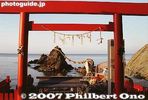
Futami Okitama Shrine does not have a main hall (Honden) like most other shrines. It worships the Okitama Sacred Stone in the ocean beyond the Wedded Rocks. 二見興玉神社
|
|

And another one. Young pretty/cute girls in costume pass out flyers, but end up being street models for amateur photographers who have no girlfriends to shoot.
|
|

Funa-zushi 鮒寿し
|
|

Kimono beauties and beans do mix well.
|
|
|
|

Juryo Division dohyo-iri ring-entering ceremony
|
|

Lantern and sunset at Futami Okitama Shrine
|
|

They are happy to pose...
|
|
|
|

Women in kimono is a must on Setsubun day.
|
|
|

Juryo sumo match
|
|

Sunset at Futami Okitama Shrine. In the old days when traveling was a hazardous undertaking in Japan, pilgrims who traveled to worship at the Ise Grand Shrines prayed here for a safe return home.
|
|

The maid costume is all the rage in Japan, for several years now.
|
|

Fish and shellfish from Lake Biwa
|
|

Minor female idols also on hand to throw beans.
|
|
|
|

Hairdressing demonstration
|
|

Santa suit appears in Dec.
|
|

Ibuki Ham
|
|

節分会に吉井怜、三津谷葉子、福下恵美が豆まく
|
|
|

Sumo match with kidsA retirement ceremony for an important sumo wrestler includes a variety of activities besides the actual ceremony of cutting away the topknot. It involves almost the entire Japan Sumo Association, and most wrestlers in the top three divisions (Makushita, Juryo, and Makunouchi) also appear in exhibition matches.
|
|
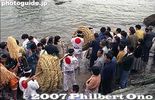
Men carry spanking-new shimenawa ropes to the rocks.
|
|

Ibuki Ham
|
|

Bikini idols Yoshii Rei, Mitsuya Yoko, and Fukushita Megumi throwing beans on Setsubun
|
|
|

A retirement ceremony for an important sumo wrestler includes a variety of activities besides the actual ceremony of cutting away the topknot. It involves almost the entire Japan Sumo Association, and most wrestlers in the top three divisions (Makushita, Juryo, and Makunouchi) also appear in exhibition matches.
|
|

Shinsengumi monument 新選組両雄の碑
|
|
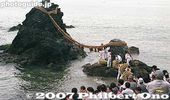
The Wedded Rocks are actually a type of torii gate for worshipping the Okitama Sacred Stone in the ocean.
|
|

Vegetable jam
|
|

Each mikoshi is preceded by a row of women carrying lanterns and wands. Also see the video at YouTube
|
|
|
|
|

Verse 2 Song Monument, Omi-Maiko (Omatsu). On the lake shore in Omi-Maiko (Omatsu) behind Hotel Biwa Lake Otsuka. Built in March 1989. 二番の歌碑。近江舞子(ホテル琵琶レイクオーツカの前)Pine trees are very green, on sands very white.
Omatsugasato is, a young maiden's home.
Bush of red camellia, hides her teary face.
She's weeping o'er a lost love, much too short to last.
Matsu wa midori ni, suna shiroki
Omatsugasato no, otomego wa
Akai tsubaki no, morikage ni
Hakanai koi ni, naku toka ya
松は緑に 砂白き
雄松が里の 乙女子は
赤い椿の 森蔭に
|
|

The torii on the larger rock is quite small. The sacred rope is replaced three times a year on May 5, September 5, and at the end of December.
|
|

Old photo of Verse 2 Song Monument in Omi-Maiko. The tree was cut down and lyrics later painted white.
|
|

Omi beef, each pack here cost over 2,000 yen. 近江牛
|
|

Magistrate's living quarters 居宅(嵐山の間)
|
|

The kids gradually get bigger.
|
|
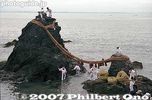
5月5日、9月5日と12月下旬には夫婦岩の大注連縄の張り替え神事が行われる。これらの写真は5月5日に撮影された。
|
|
|
|

Ozeki Musoyama is defeated.
|
|

Verse 2 monument is on the lake shore, in front of Hotel Biwa Lake Otsuka, near what appears to be a boat pier. Short walk from Omi-Maiko Station.Directions: Near Omi-Maiko Station on the JR Kosei Line. After exiting the station, walk left toward Kitahama. Then get to the lake shore and walk along the lakeshore road until you see the monument under a large tree right on the shore. It is in front of Hotel Biwa Lake Otsuka.
|
|
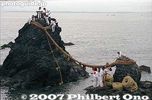
The men begin to cut off the old rope. Those sharp sickles soon made short work of the old sacred ropes which were brought ashore in small pieces.
|
|

Stamp of Approval from Shiga
|
|
|

Yobidashi wearing Aloha-print garb
|
|
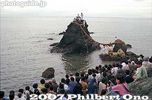
The ceremony attracts a large crowd.
|
|

Mochi making
|
|

Bean throwers make speeches.
|
|
|
|
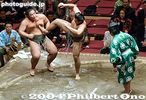
Comic sumo (shokkiri sumo)This is comedy time with two young wrestlers performing various comical antics (spitting at each other, kicking, and other illegal sumo acts) on the ring.
|
|

Across the road from the Verse 2 song monument is this small music box. Press the button and you can hear the song play (sung by Kato Tokiko).
|
|

The shimenawa rope actually consists of five smaller ropes. They cut the ropes one by one.
|
|

Mochi
|
|
|

Comic sumo (shokkiri sumo)This is comedy time with two young wrestlers performing various comical antics (spitting at each other, kicking, and other illegal sumo acts) on the ring.
|
|

The ropes are now completely cut, breaking the bond between the two rocks.
|
|

Adoberry sweets, from Adogawa, Takashima.
|
|

Miss Nippon somethings
|
|
|

Tidying up the ring
|
|
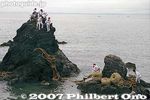
The old rope is taken away.
|
|
|

Adoberry sweets, from Adogawa, Takashima.
|
|

Throw the beans farther!
|
|

Musashimaru finally appears for a yokozuna belt demo
|
|

Procession maidens pose with the giant penis. The giant phallus was then partially hidden by the portable shrine as it is today. But this made the phallus become larger to 2.5 meters, as if to compensate for this partial shielding.
|
|

The new ropes are strung across the two rocks. A small rope tied to the end of the large rope is used to pull the large rope up the rock.
|
|

Bath area
|
|
|
|

Fuku wa uchi!!
|
|

Palanquin maidens.
|
|

Musashimaru acknowledges a spectator as he proceeds to the ring.This was a demonstration on how they tie on the thick, white rope (tsuna) around his waist. The tsuna is the symbol of the yokozuna. It takes several assistants to put it on. They are all wearing white gloves.
|
|
|
|

Toilet
|
|

This mikoshi is being carried by all women, already soaked to the bone. They carry the mikoshi flat on their shoulders. This is called "Hira katsugi," literally "flat carrying."There are four basic methods of carrying a portable shrine. This is the most basic method where they carry it flat on their shoulders. This is called "Hira katsugi," literally "flat carrying."
|
|

Entrance to crafts booths. 工芸展
|
|

Setsubun bean throwing at Takahata Fudoson temple, Hino, Tokyo
|
|

Yokozuna "tsuna" belt demo
|
|

The first rope is wound around both rocks.
|
|

Kitchen
|
|

Omi crafts booths
|
|

Setsubun bean throwing at Takahata Fudoson temple, Hino, Tokyo
|
|

They wrap the rope around his waist from the front, or the thickest part of the rope.This was a demonstration on how they tie on the thick, white rope (tsuna) around his waist. The tsuna is the symbol of the yokozuna. It takes several assistants to put it on. They are all wearing white gloves.
|
|

The second rope is installed.
|
|
|
|

Kimono in the middle costs 1,995,000 yen. However the most expensive thing I saw was a Buddhist altar selling for 40 million yen (lots of gold leaf).
|
|

Pulling it tight
|
|
|

Making candles.
|
|

Large Hall (Dai-hiroma)
|
|
|

One by one, the men carefully positioned the new sacred ropes on the two Rocks. All the while, young children and young men are chanting on the shore.
|
|
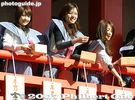
Bikini idols Yoshii Rei, Mitsuya Yoko, and Fukushita Megumi throw beans a second time.
|
|

Large Hall (Dai-hiroma) where ceremonies and meetings were held. It could also be partitioned into three rooms. Total area is 48 tatami mats. 大広間
|
|

Tying the rope at the back.
|
|
|
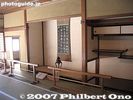
Tokonoma alcove
|
|

Rear view of the shiranui style of tying the rope.He turned in all four directions to show everyone what it looked like. This is what is called the shiranui style of tying the rope. It is characterized by a single loop in the back. The other style, called unryu, has twin loops.
|
|
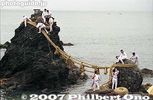
Replacing the rope for the Wedded Rocks, Mie Pref.
|
|
|

Musashimaru goes back and then comes back...
|
|

Five ropes are being positioned and made taut.
|
|
|
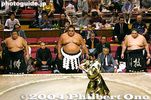
He performs his last yokozuna dohyo-iri ring-entering ceremony. He is flanked by Musoyama on the left as the sword bearer, and Miyabiyama on the right as the dew sweeper.
|
|
|
|

Palanquin
|
|
|

Musashimaru's final dohyo-iriHe could have had Yokozuna Asashoryu be either the sword bearer or dew sweeper, but he chose to have his stablemates to join his final dohyo-iri.
|
|

All the while, the cheering section chants and wave streamers.
|
|
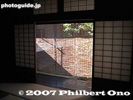
Bamboo screen
|
|

Musashimaru's final dohyo-iri
|
|
|

Bamboo screen
|
|
|
|

Musashimaru's final dohyo-iri
|
|

Maids to greet you
|
|

Maids, the costume rage in Japan for several years already.
|
|

Welcome!
|
|
|

Tokyo Anime Center
|
|

Many life-size costumed characters on display.
|
|
|

Tokyo Anime Center, Akihabara
|
|

Big expressive eyes.
|
|

Straight black hair is pretty too.
|
|

Blue ponytails
|
|

Goldilocks?
|
|

Space teen?
|
|
|

School uniform
|
|
|

Redhead in school uniform
|
|
|
|
|

With raised arms, this is one way to carry the mikoshi.
|
|

Splashing water
|
|

Torture room 吟味所・御白洲
|
|

Musashimaru's final dohyo-iri
|
|

Anybody who knows the names of these characters are welcome to enlighten me...
|
|

Sakura
|
|

Merry Christmas
|
|
|
|
|
|
|

Pikachu, Astro Boy, Doraemon
|
|
|
|

Men with buckets come for a refill.
|
|
|

Musashimaru's final dohyo-iri ends
|
|

Verse 3 Song Monument, Imazu. A lantern, at the end of the pier at Imazu Port. 三番の歌碑。今津港の桟橋。夜に赤く点灯。This is at the end of Imazu Pier. At night, this lamp lights up in red. You can see Chikubushima island and Mt. Ibuki in the background.
|
|

Pieces of the old rope. Anyone could take home the pieces of old sacred rope if they wanted.
|
|
|

Entrance to Rice Storehouse. 御蔵
|
|

He goes back to the dressing room
|
|

Making sure that the rope is aligned and positioned correctly.
|
|

Verse 3 Song Monument
|
|

They get pretty crazy, getting more water.
|
|
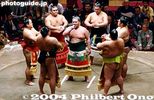
Sumo jinkuThey are singing sumo jinku, a chant-like song about sumo and sumo wrestlers. They are singing about Musashimaru and his career.
|
|
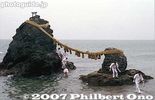
The job is finished.
|
|
|

Laying the red carpet for the main event.
|
|

The rope installers return to shore.
|
|
|

This must be a first, a kumu hula (hula teacher) from Hawaii performing on the sumo ring.He is Sonny Ching, a well-known hula teacher in Hawaii. He brought four male hula dancers who danced at the four corners of the ring.
|
|
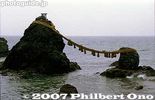
Wedded Rocks with a new rope. Japan has numerous other Wedded Rocks and stones, but this is by far the most famous.
|
|

Konomiya Hadaka Festival, Inazawa, Aichi Pref.
|
|

Kumu hula Sonny Ching beats the ipu gourd drum, a traditional Hawaiian instrument. This must be a first, a kumu hula performing on the sumo ring in Japan.
|
|

Verse 3 Song Monument is written with Verse 3.We drift from wave to wave, straying aimlessly.
On shore we see red fire, brings back memories.
With our sights set nowhere, rolling with the waves.
Today is Imazu or, Nagahama huh.
Nami no mani mani, tadayoeba
Akai tomaribi, natsukashimi
Yukue sadamenu, nami makura
Kyo wa Imazu ka, Nagahama ka
浪のまにまに 漂えば
赤い泊火 懐かしみ
行方定めぬ 浪枕
今日は今津か 長浜か
|
|
|

Male hula dancer at one cornerThe original plan was for the hula dancers to perform on the ring itself. But at the last minute, Musashimaru decided that it was not appropriate so they danced outside the ring.
|
|

Imazu Port. Verse 3 Song Monument is at the end of the dock. The same dock used by boats going to Chikubushima. The dock is usually closed.Chikubushima island and Mt. Ibuki can be seen.
|
|

All the men look in the direction of the Sacred Man.
|
|

Calling Musashimaru (with a conch shell)
|
|
| 3695 files on 15 page(s) |
1 |
 |
 |
 |
 |
|